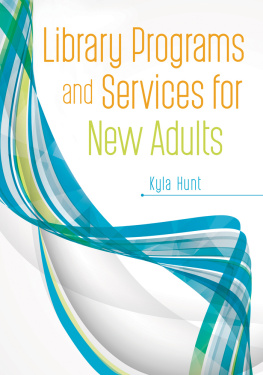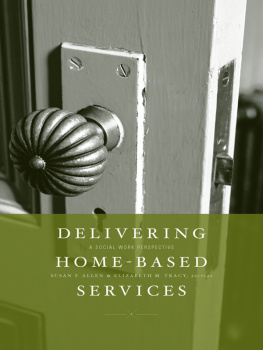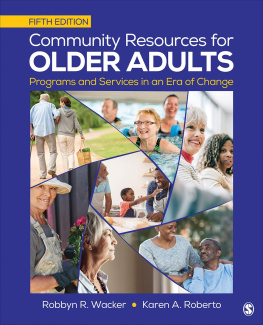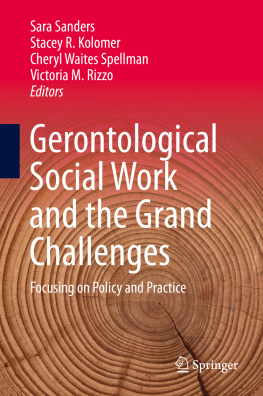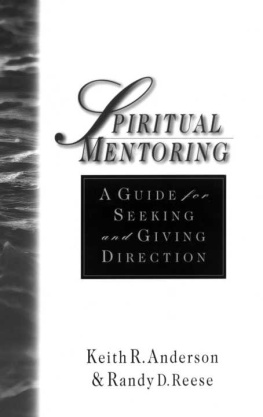HOME- AND COMMUNITY-BASED SERVICES FOR OLDER ADULTS
HOME- AND COMMUNITY-BASED SERVICES FOR OLDER ADULTS
AGING IN CONTEXT
By Keith A. Anderson, Holly I. Dabelko-Schoeny, and Noelle L. Fields

COLUMBIA UNIVERSITY PRESS NEW YORK
COLUMBIA UNIVERSITY PRESS
Publishers Since 1893
New York Chichester, West Sussex
cup.columbia.edu
Copyright 2018 Columbia University Press
All rights reserved
EISBN: 978-0-231-54699-7
Library of Congress Cataloging-in-Publication Data
Names: Anderson, Keith A., author. | Dabelko-Schoeny, Holly I., author. | Fields, Noelle L., author.
Title: Home- and community-based services for older adults : aging in context / by Keith A. Anderson, Holly I. Dabelko-Schoeny, and Noelle L. Fields.
Description: New York : Columbia University Press, [2018] | Includes bibliographical references and index.
Identifiers: LCCN 2017048967 (print) | LCCN 2017053510 (e-book) | ISBN 9780231546997 (E-book) | ISBN 9780231177689 (cloth) | ISBN 9780231177696 (pbk.)
Subjects: LCSH: Older peopleMedical careUnited States. | Older peopleCareUnited States. | Older peopleServices forUnited States. | Home care servicesUnited States. | Community health services for older peopleUnited States.
Classification: LCC RA564.8 (e-book) | LCC RA564.8 .A525 2018 (print) | DDC 362.19897/00973dc23
LC record available at https://lccn.loc.gov/2017048967
A Columbia University Press E-book.
CUP would be pleased to hear about your reading experience with this e-book at .
Cover design: Jordan Wannemacher
Cover image: Jamie Heiden / Trevillion Images
I WOULD LIKE TO ACKNOWLEDGE the support and love of my father, George V. Anderson Jr., who is aging with grace, and my mother, Helen L. Anderson, who never grew old.
Keith A. Anderson
I would like to thank Steve Schoeny for helping me balance the demands of being an academic with being a mother to our sons, Geoffrey and Nate. I am grateful to my parents, Dr. David and Elaine Dabelko, for teaching me to love the process of discovery and to respect all people. Finally, I am thankful for Nana, Granddad, Grandma, and Zeddo, whose lives provide me with inspiration.
Holly I. Dabelko-Schoeny
Thank you to Justin and Libby Fields for all of the joy and love that you bring to my life. I am also grateful for my parents, Dr. Hap and Blakie LeCrone, for all of their support and for instilling in me a love and respect for older adults.
Noelle L. Fields
The authors also thank our doctoral student, KyongWeon Kathy Lee, for her assistance in the preparation of this book. Finally, the authors acknowledge the guidance of our friend and mentor, Dr. Virginia E. Richardson, who continues to inspire and shape our careers.
Among the various places that become meaningful for us, home is the single most significant one. Beyond meeting the need for shelter, a true home is where we can be ourselves and be at home. Home sets the stage of our life experience; it is the psychological and emotional frame of reference from which we relate to all other places and life experiences. It is the space where we express ourselves and socially interact and where events of joy and sorrow take place. Home is where we grow old and become comfortable; it provides a setting where we can manage our daily lives in spite of physical frailty.
CHOUDHURY, 2008, pp. 78
THE POPULATION OF THE UNITED States is aging, and we have all heard the clich references to the Silver Tsunami and the Graying of America. As the baby boomer generation (born between 1946 and 1964) continues to move into old age, our already strained systems of care for older adults will face a monumentally increased burden. The aging of the population presents challenges, but we also see opportunities for creative approaches to caring for older adults and for supporting their family caregivers in their preferred settingat home and in the community. Our homes and the communities in which we live have deep significance. This significance is magnified in later life and in illness. Home is where we find strength, support, and renewal. Nobody wants to be sick and to need care. But when we do, we want to be in our own homes and be cared for in our communities of family, friends, and neighbors. Home- and community-based services (HCBS) are exactly what the name implieshealth care and support services delivered to the residences and the neighborhoods where older adults and their family caregivers live. HCBS are cost-effective and the preferred platform for service delivery to older adults and their families. Given the benefits and capacities to provide care, HCBS may hold the key to solving the challenges of our aging society. As such, HCBS merit the attention of researchers, policy makers, and practitioners.
This book introduces you to the policies, settings, services, successes, and challenges associated with HCBS. The target audience are students in the health professions, such as nursing, social work, and allied health services (for example, physical therapy or occupational therapy). Students in public health and health care management fields also may find this topic of interest, particularly in light of the policy-related and service-oriented challenges facing society as we care for a growing older adult population. Some of the topics may be familiar to you from prior learning or life experiences. For example, you may have a family member who is a resident in an assisted living facility. Other topics may cover new ground, such as the resurgence of home-based primary care (house calls) or the ever-advancing technology of smart homes. As you read, we hope you will share our enthusiasm for the continued development of HCBS that are humane, holistic, and person- and family-centered.
Conspicuously, this book does not contain a chapter on nursing home care. This intentional omission directly reflects our firm belief that our systems of care will continue to move away from institutional care and toward HCBS. It may be surprising to learn that only 4.2 percent of older adults use nursing home care and that the number of nursing home residents has steadily declined from a high of 1,628,300 in 1999 to 1,369,700 in 2014 (Harris-Kojetin et al., 2016). This trend has occurred despite the growing number of older adults. Length of stay in nursing homes is also declining, indicating that older adults are either being discharged to home care or that older adults are using nursing homes for end-of-life care only, similar to hospice (Department of Health and Human Services [DHHS], 2016). Another factor to consider is the prohibitive cost of nursing home care. Nursing home care is 2 to 4 times more expensive than HCBS (Genworth Financial, 2016). Finally, the capacities of HCBS are growing, and we can now provide levels of care in the home and community that previously could only be provided in the nursing home setting. For all of these reasons, the nursing home is becoming an unwanted, outdated, and ineffective approach to caring for the overwhelming majority of older adults. Will nursing homes disappear in the future? Probably not; however, they may someday resemble inpatient hospices where older adults come only at the very end of their life.


 COLUMBIA UNIVERSITY PRESS NEW YORK
COLUMBIA UNIVERSITY PRESS NEW YORK
















